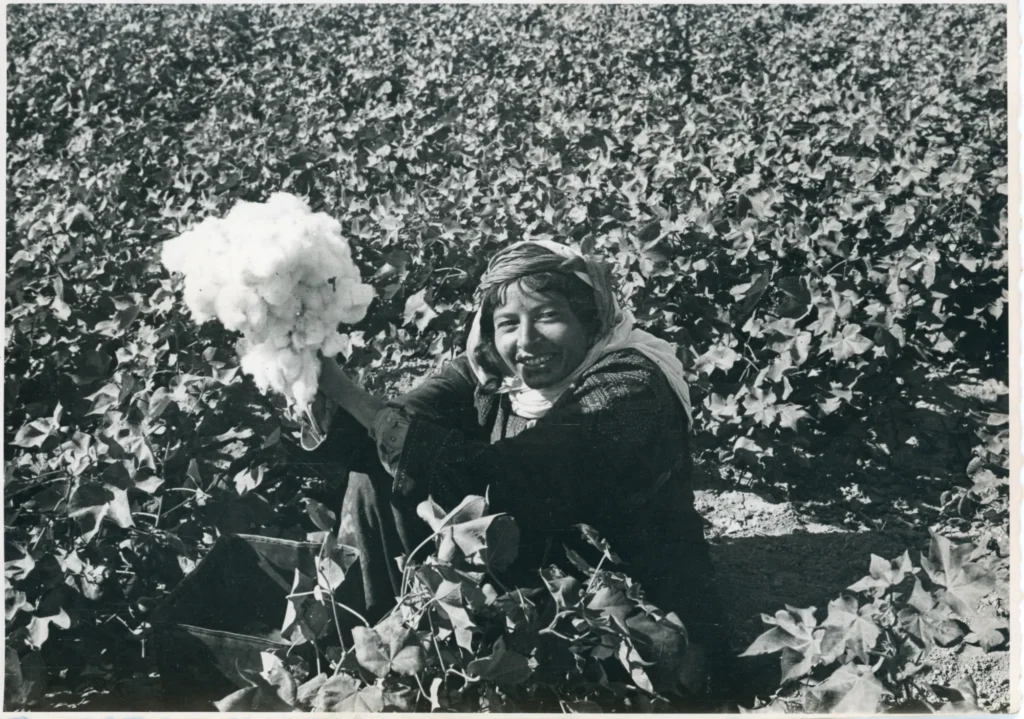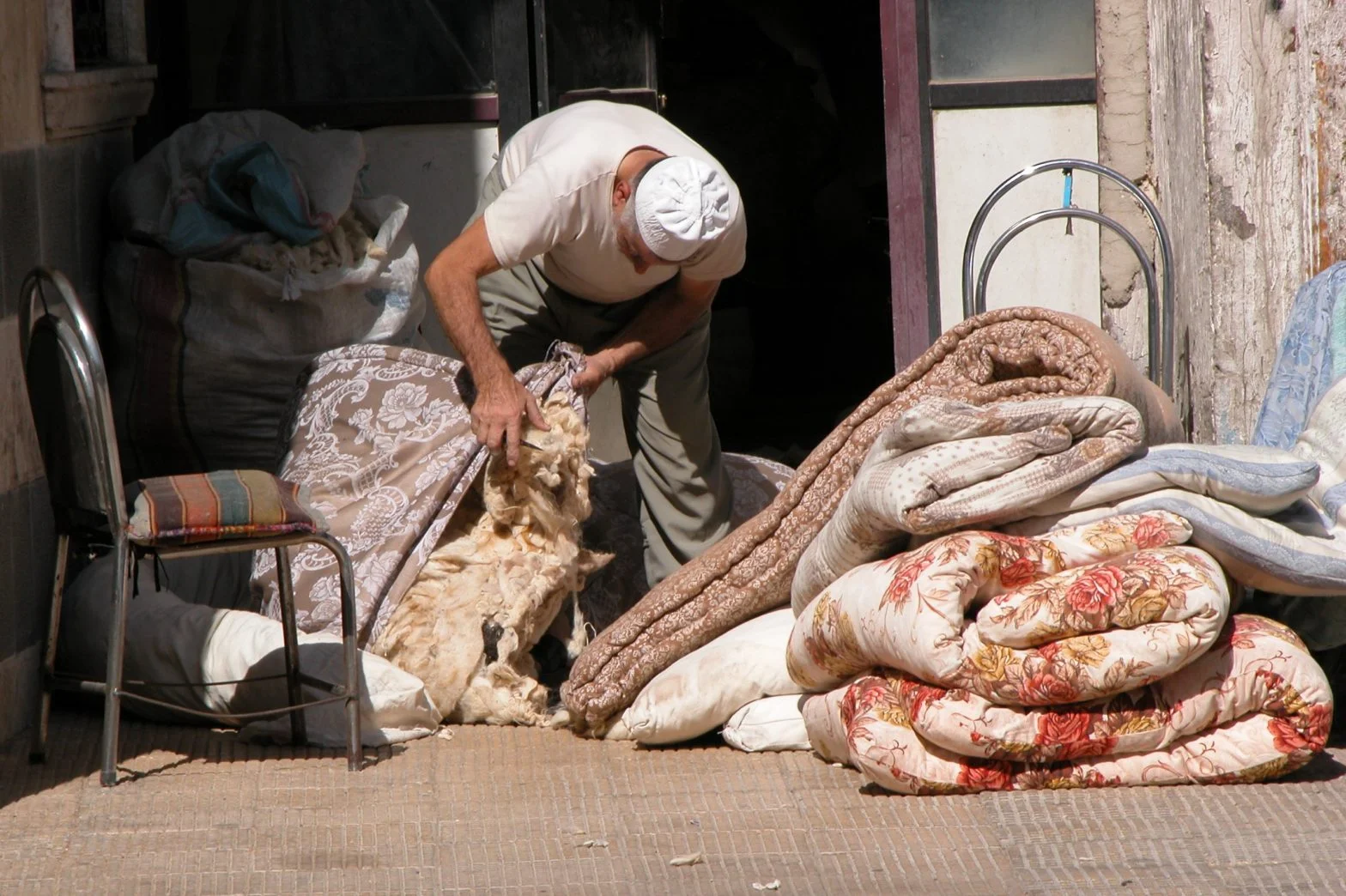by Estibaliz Sienra Iracheta
Traditional textiles activities have been vital in the connection between humans to nature, providing a deep knowledge of the plants, animals and minerals coming from the environment. As artefacts that allow for survival in extreme weather conditions and that help with the undertaking of our daily lives, the obtention of natural fibers has been related to human knowledge and advancements, including the domestication of animals and the cultivation of crops.
Silk

The production of damasks and brocades is closely related to the historic legacy of silk, or harir, in Syria. Originally discovered in China, the breeding of silkworms and the processing of its fiber was kept as a closely-guarded secret for Centuries, and even though the date of the dissemination of sericulture is unknown, it is assumed that the activity was propagated beyond the Far East through the emergence and establishment of the Silk Road.
The ancient network of trade routes had three important branches that ended in Syrian cities: an overland connection from Central Asia via Persia and Iraq to Aleppo and Antioch; and by a sea-route, connecting India to the Persian Gulf, and then by land from Baghdad or Mosul to Aleppo, Palmyra or Damascus. In the suqs from these cities, the finest silk threads and fabrics could be acquired to be transported and sold in Europe and the Mediterranean. It is known that the Roman Empire imported oriental silk from Syria and that the sericarii or silk merchants had their own quarters in the city of Rome. Furthermore, the weaving of weft twill silks using draw looms originated in the region and was later introduced to the Persian Empire by Syrian-roman slaves who were taken prisoners by the Sasanian Emperor Shapur I in the year 360 (Harris, p.60; Scott, p.52; Pavaloi, p.215). Weft twill is a kind of weave that consists of horizontal threads, called weft, and diagonal threads, called warp. The diagonal pattern is created by passing the weft over one or two threads of the warp, then under two or more warps shifting the lines for the diagonal line. Twill is both the name of these diagonal weaves as well as the final weave fabric. The Diocletian edicts (301 AC) also concern textile manufacturing in Syria and referenced silk production and loom quantities for the weaving of pure damask fabrics (Pavaloi, p. 211). Larger silk production was probably developed during the Byzantine epoch by Nestorian priests in 553, later flourishing in the cities of Homs and Hama, when the Muslim armies under Khalid b. al-Walid conquered the region. The tributes paid by the Damascenes to their conquerors included “two thousand silk garments… and three hundred camel-loads of silk” (Pavaloi, 1992, p. 212).
The natural silk filament became one of the most priced goods in the Caliphates and as with its Roman predecessors, became a valuable element of Islamic culture. Silk clothes began to be used as gifts and symbols for the “recognition or expressions of benevolence from the powerful to their subordinates” (Lombard, 1987). It was also closely related to material and spiritual values among all stratums of the social hierarchy and among different religious groups, from the upper courts of the Umayyad’s to the rural and nomad populations of today.
The small village of Dayr Mama in the Masyaf region is renowned for the production of natural silk until today. Located on the eastern side of the coastal mountains, the optimal natural environment and moderate climate has allowed the art of sericulture to continue over the centuries, preserved by the dedicated hands of their inhabitants. The villagers have worked to save the silk industry from extinction by transferring the knowledge to their children and grandchildren, and by opening a museum that shows the historical and cultural relevance of the fiber and its production in the region.
The obtention of silk begins with the domestication of the Bombyx mori silkworms, a process determined by the four phases of the insect’s life cycle: the growing from the egg into a larva, from larva into a chrysalis, and finally, into a butterfly. In former times Syrian farmers cultivated their own silkworm eggs, but at present, they are bought from the Ministry of Agriculture and Agricultural Reform of Syria. The eggs remain apparently inactive during summer, autumn and winter, until spring when the larvae finally hatch. This coincides precisely with the time of the year when the mulberry trees bloom. The silkworm larvae are placed on mattresses and kept inside boxes in the house. The larvae are then fed three times a day with mulberry leaves for six weeks, growing into adulthood after shedding skin five times and growing up to seven or eight centimetres. At the end of their adult life, the worms turn translucent, indicating the time when they are ready to weave their cocoons. Being provided with dry shrub branches from which they hang, the warms secrete the silk filament and wrap themselves, a task that takes three to four days to complete. The cocoon will protect the worm until it is metamorphosed into a chrysalis, a transformation that takes between two or three weeks, and after which the butterfly breaks the cocoon and leaves. In the following eight to twelve days, the butterflies will mate and lay between 200 and 300 eggs before dying.
Sericulturists collect the cocoons and divide them into two categories, depending on their size and quality. The good ones are then sent to the reeling process, where the single hardened silk filament of the cocoons is softened in boiling water and individually unwounded with help of a wheel. Each cocoon is produced from a single filament that can measure up to 1,500 continuous metres in length. Two filaments are then combined and twisted to form a single silk thread, using a spinning wheel or a spindle. The threads are then reeled again to form spools of yarn that can be used for crocheting or weaving (Alkateb, 2011).
Wool
The production and use of wool – obtained mainly from Awassi sheep – has been particularly relevant among the Bedouins and agricultural peasants of Syria, who have been keeping flocks and herding them into the natural grasslands of the semi-arid or arid regions of southwest Asia for more than 5,000 years (Epstein, 1980).
The processing of wool begins with the shearing of the sheep, usually done during summertime, using hand shears or scissors. The wool fleece is then washed at home with warm water to remove any organic material like dung or thorns. After drying under the sun or next to a fire, the bundles of wool are beaten with canes or a bow to loosen the fibres. This is followed by the carding, which facilitates the spinning or felting process, by separating and organising the fibres in one direction with help of spiked tool or comb. Once the carding is finished, the wool can be sold in the markets or spun into threads at home to weave resistant textiles like coats or tapestries. The use of camel and goat hair was also very popular among Bedouins, as the fibres tend to be soft and fine but extremely resistant. The hairs were used to weave tent strips, kilims, bags, bands, belts and girths. Camelid wool was also spun into fine threads and was especially used to weave some of the most expensive festive cloaks or abayas worn by the richest of Bedouins.
Cotton

Cotton is a vegetable textile fibre, growing from the shrubs of the Gossypium genus. Known as qutn in Arabic, the domesticated crop was probably first introduced into Syria from India following trade routes more than 2,000 years ago. However, by the late Middle Ages, the relevance and volume of cotton production in the olden territories of Syria had developed to such an extent, that the region exported the largest quantities of raw cotton to Europe, supporting the flourishing of the fustian industries in Lombardy and southern Germany. By the end of the 15th Century, cotton from Hama was considered the best in all of European markets, with Venetians sending two convoys per year to the region and importing between 5,000 to 8,000 sacks of raw cotton and cotton threads on every trip (Gibb, 1954, p.556).
The cropping of cotton starts with the planting of the seeds during rainy seasons. A few months later, the plant blossoms flowers, which after withering, form a green capsule that ripens and opens to reveal the fluffy fibres of cotton that cover the seeds. The opening of the buds marks the beginning of the recollection time, which used to be done by hand but is currently done with machinery.
Estibaliz Sienra Iracheta is a Doctorate candidate in World Heritage Studies at Brandenburgische Technische Universität Cottbus, and is a promoter and expert in traditional textiles. Estibaliz previously worked in the Ruth D. Lechuga Folk Art Collection of the Franz Mayer Museum and as a teacher at the Textile Restoration Workshop of the National School for Conservation, Restoration and Museography of the National Institute of Anthropology and History of Mexico.

